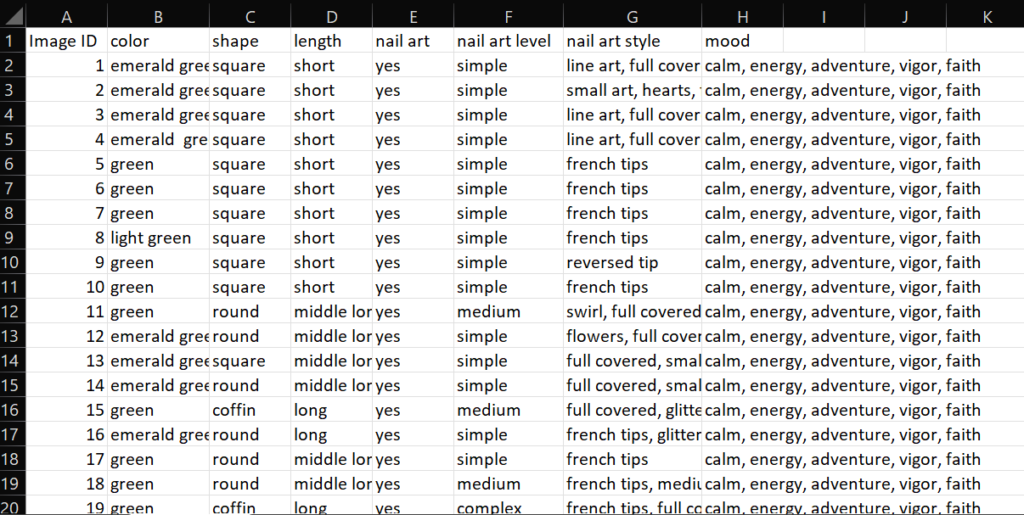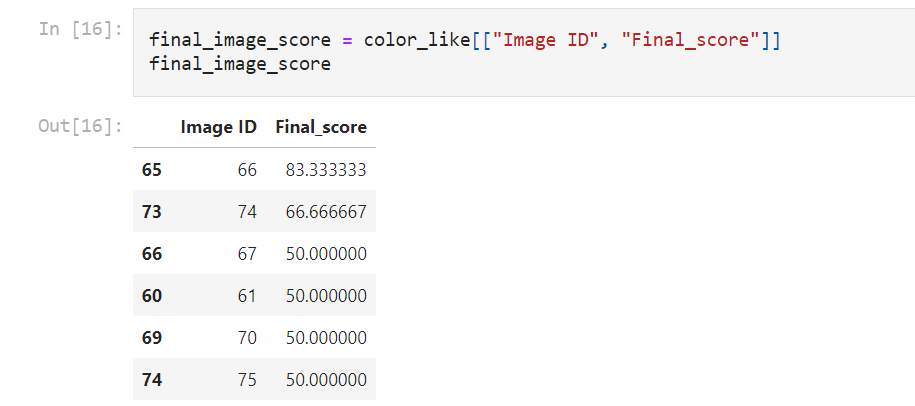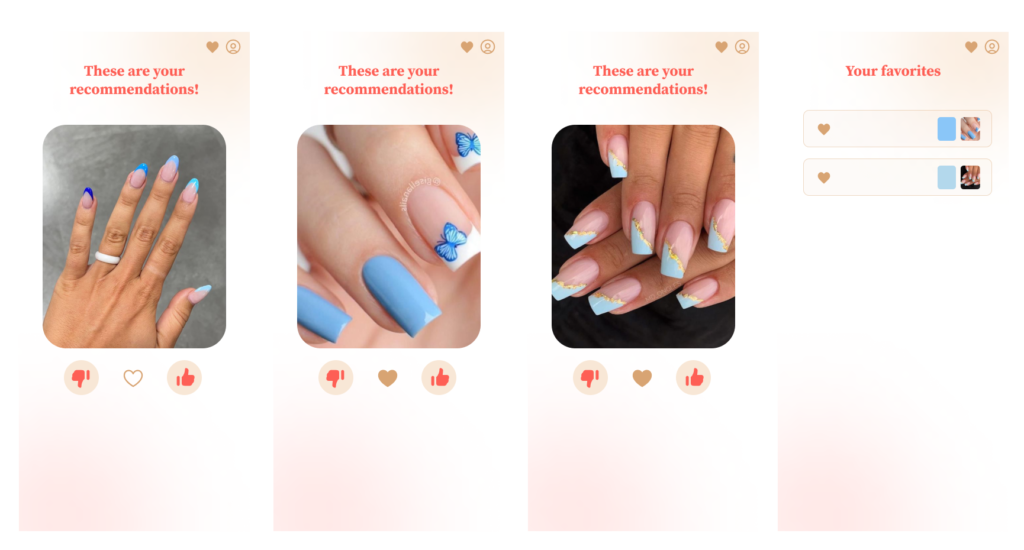Premise
Using a recommender system to explore what variables to consider when building nail design recommendations (such as color, shape, length, design, or pattern) that will improve the personalized recommender system for women.
Synopsis
When going to a nail salon, women can choose from a range of different colors and designs. This can lead to not knowing what to choose, experiencing choice overload, or having difficulty making decisions. One solution to reduce this can be a recommender system that provides the best-suited nail design recommendations. However, building this recommender system requires more research about the importance of variables that need to be considered when building the system because it is not yet clear what factors women consider important for their decision-making process.
This project therefore aims to explore and develop a recommender system that takes into account different variables, such as color, shape, length, and design, to find out what the most important variables are for personalized nail design recommendations.
Topic
Problem
The number of products in the nail industry is globally expected to grow at a 6.8% rate on a yearly basis (Grand View Research, 2022). This included the production of more nail products, such as various nail colors and different types of nail treatments (Polaris Market Research, 2022). The excessive production of products can cause choice overload among customers (Gerasimou & Papi, 2018; Mitchell & Papavassiliou, 1999). Choice overload occurs when people cognitively can’t process any more information or the amount of different items than the person’s limit, which can result in less motivation, less satisfaction with the made decision, and stress (Gerasimou & Papi, 2018; Iyengar & Lepper, 2000; Mick et al., 2004; Scheibehenne et al., 2010; Schwartz, 2004). Therefore, some women may experience choice overload or decision difficulties when choosing a nail design in the nail salon. However, it is still unclear how women make their nail design choices when choosing a nail design.
Most important insights
Preliminary research insights
The preliminary research focused on researching the problem space by determining whether women experience choice overload before or during their nail salon visit. The results of this survey showed that more than 60% of the women experienced choice overload when making a decision about their nail treatment.
Literature insights
The insights from the literature gave a better understanding of human values. The study focused on the causes and solutions of choice overload and the decision-making processes of people. Choice overload can be influenced by different factors, such as time pressure, decision task difficulty, choice set complexity, preference uncertainty, and decision goal (Chernev et al., 2015; Inbar et al., 2011).
There are different options to reduce choice overload, such as minimizing the set of alternatives, simplifying the presented items, and categorizing items (Gourville, 2005; Iyengar & Lepper, 2000; Mogilner et al., 2008). These solutions can be taken into account when building the recommender system and designing the interface.
Scope of the research
The problem of reducing choice overload when choosing a nail design is a larger issue that must be broken down into smaller steps. Therefore, the scope of this project focuses on what variables need to be considered when building a nail design recommendation system for women.
A recommender system is used as a solution to provide the user with suitable nail design images because these systems are specifically focused on serving the user personal recommendations for products or services (Theosaksomo & Widyantoro, 2019). Content-based filtering focuses on the matching aspects of items and therefore is used as a technique to recommend nail design images to the user based on content she might like (Son & Kim, 2017).
Project process
Iteration 1
The dataset
There is no existing dataset available that contains characteristics of nail design images. Therefore, the dataset had to be collected manually and was hence smaller in size. I collected nail design images from Pinterest and labeled them based on the following characteristics: color, shape, length, nail art, and mood. The mood characteristic was tested in the second iteration. To narrow down the values of characteristics, the dataset only focuses on a few values per characteristic, such as six kinds of colors and three nail shapes.

The prototype
When the dataset was collected and cleaned, the first prototype was made in Python (see the code). The goal is to use the main characteristics of the nail design images for making the recommendations. The user fills in her nail preferences, and the system goes through all the characteristics of all nail design images to find similar items by giving them a score of one or zero. This results in a list of the most similar nail design images based on the user’s input.
I tested the first prototype with three women who do their nails every two weeks. The test resulted in the following insights:
- The series of questions made the decision-making easier.
- The users wanted options in color groups, such as dark or light.
- The users wanted options for topic layers, such as shiny or matte.
- The users wanted to see images of the final recommendations.
- The recommendations assign nail images with the most similar values on top, but they don’t take into account the importance of the characteristics.
Based on these insights, for the next iteration, the recommender system needs to be improved by expanding the dataset with two new variables, namely the color group and topic layer, and by assigning weight to variables so the system knows which characteristics are more important. It also needs to show images of the best-suited recommendations for the user.



Iteration 2
The second prototype focuses on adding more playful variables to the dataset, like the mood and season variables. Unlike the variables from the first iteration, these are indirectly linked to the nail color. In order to connect the mood and the season to nail characteristics, research had to be done. I labeled the mood variable based on the Claudio Cortes color-to-emotion table, which was provided in Nijdam (2009), and I used a list of nail polish meanings created by a color expert (Olesen, n.d.). To label the seasons, I used the traditional season color palette by Cayghill (1980).

The second prototype was tested with three women who do their nails often. The test resulted in the following insights:
- The questions about the seasons were useful.
- Users found the recommendations similar to their preferences.
- Users also wanted an option to add images to their favorites list.
- Users want a visual interface when going through the questions.
Based on these insights, the next iteration will be focused on creating a user interface. In this user interface, the feedback points will be implemented.




Iteration 3
For the third prototype, there will be a Figma prototype to give users an idea of what the interface will look like. In the prototype, the user can click her preferences and see her end recommendations. She can like or dislike her recommendations and save it to her favorites list. See the prototype.
The prototype was tested with four women who do their nails occasionally. The test resulted in the following insights:
- Users liked the visual interactive interface and found it easy to go through.
- Users found the emotion question poorly placed. It should be one of the first questions instead of the last because it is a more general question.
- The interface should be more user-friendly; the side arrows were unclear to users.
- Users didn’t know to what extent they liked the images with only thumbs up and thumbs down.
- Users would like to have a filter for occasions.
In the next steps, the Figma prototype needs to be more user-friendly and have a better structure. To help the user give better image ratings, the prototype will use five heart ratings instead of one like and dislike button. The dataset also needs to be expanded with an occasion variable.


Conclusion
Based on the insights of this project, it is clear that the most important variables to consider for building a nail design recommender system are the color, the color group, shape, nailart, topic effect, mood, season, occasion, favorites of the user, and ratings of already seen images. However, more research and testing are needed for assigning values to the variables. For instance, to understand what colors or shapes belong to certain occasions. This project also gave insights into the decision-making process of different women’s nail design choices. For instance, women who do their nails occasionally found it more important to match their nails based on the specific occasion than women who do their nails frequently.
The recommender system did a good job of recommending images based on the user’s preferences. However, to improve the recommendations even more, a bigger dataset would suit the needs of all user preferences. In further iterations, it’s also important to improve the recommender system by giving the user the opportunity to choose multiple options instead of one and to look into preventing the cold start problem.
References
Caygill, S. (1980). Color the Essence of You [eBook edition]. Celestial Arts. https://hdl.handle.net/1813/55002
Chernev, A., Böckenholt, U., & Goodman, J. (2015). Choice overload: A conceptual review and meta-analysis. Journal of Consumer Psychology, 25(2), 333-358. https://doi.org/10.1016/j.jcps.2014.08.002
Gerasimou, G., & Papi, M. (2018). Duopolistic competition with choice-overloaded consumers. European Economic Review, 101, 330-353. https://doi.org/10.1016/j.euroecorev.2017.10.002
Gourville, J. T., & Soman, D. (2005). Overchoice and assortment type: When and why variety backfires. Marketing science, 24(3), 382-395. https://doi.org/10.1287/mksc.1040.0109
Grand View Research. (2022). Nail Polish Market Size, Share & Trends Analysis Report By Product (Regular Nail Polish, Gel Nail Polish), By Distribution Channel (Hypermarkets And Supermarkets, Specialty Stores, E-commerce), By Region, And Segment Forecasts, 2023 – 2030. https://www.grandviewresearch.com/industry-analysis/nail-polish-market
Inbar, Y., Botti, S., & Hanko, K. (2011). Decision speed and choice regret: When haste feels like waste. Journal of Experimental Social Psychology, 47(3), 533-540. https://doi.org/10.1016/j.jesp.2011.01.011
Iyengar, S. S., & Lepper, M. R. (2000). When choice is demotivating: Can one desire too much of a good thing?. Journal of personality and social psychology, 79(6), 995. https://doi.org/10.1037/0022-3514.79.6.995
Mick, D.G., Broniarczyk, S.M. & Haidt, J. Choose, Choose, Choose, Choose, Choose, Choose, Choose: Emerging and Prospective Research on the Deleterious Effects of Living in Consumer Hyperchoice. Journal of Business Ethics 52, 207–211 (2004). https://doi.org/10.1023/B:BUSI.0000035906.74034.d4
Mitchell, V. W., & Papavassiliou, V. (1999). Marketing causes and implications of consumer confusion. Journal of Product & Brand Management, 8(4), 319-342. https://doi.org/10.1108/10610429910284300
Mogilner, C., Rudnick, T., & Iyengar, S. S. (2008). The mere categorization effect: How the presence of categories increases choosers’ perceptions of assortment variety and outcome satisfaction. Journal of consumer Research, 35(2), 202-215. https://doi.org/10.1086/588698
Olesen, J. (n.d.). The Meaning of Your Nail Polish Color. Color Meanings. Retrieved from March 6, 2023, from https://www.color-meanings.com/the-most-popular-nail-color/
Polaris Market Research. (2022, November). Nail Care Products Market Share, Size, Trends, Industry Analysis Report, By Product (Nail Polish, Artificial Nail & Accessories); By End Use; By Region; Segment Forecast, 2022 – 2030. https://www.polarismarketresearch.com/industry-analysis/nail-care-products-market
Scheibehenne, B., Greifeneder, R., & Todd, P. M. (2010). Can there ever be too many options? A meta-analytic review of choice overload. Journal of consumer research, 37(3), 409-425. https://doi.org/10.1086/651235
Schwartz, B. (2004). The paradox of choice: Why more is less. Retrieved February 28, 2023, from http://works.swarthmore.edu/fac-psychology/198
Son, J., & Kim, S. B. (2017). Content-based filtering for recommendation systems using multiattribute networks. Expert Systems with Applications, 89, 404-412. https://doi.org/10.1016/j.eswa.2017.08.008
Theosaksomo, D., & Widyantoro, D. H. (2019, October). Conversational recommender system chatbot based on functional requirement. In 2019 IEEE 13th International Conference on Telecommunication Systems, Services, and Applications (TSSA) (pp. 154-159). IEEE. DOI: 10.1109/TSSA48701.2019.8985467.